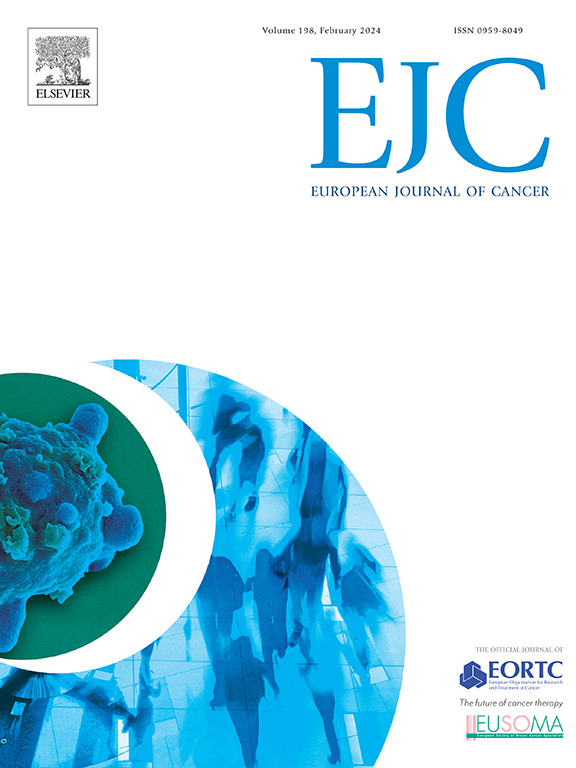Correlation between irAEs and survival outcomes in patients with ES-SCLC treated with first-line chemoimmunotherapy
IF 7.6
1区 医学
Q1 ONCOLOGY
引用次数: 0
Abstract
Introduction
Chemo-immunotherapy (CT-IO) has improved median overall survival (mOS) for patients with extensive-stage small cell lung cancer (ES-SCLC), but its association with immune-related adverse events (irAEs) remains unclear. While irAEs are often linked to better outcomes in other cancers, their prognostic value in ES-SCLC is not well understood.
Methods
We conducted a retrospective analysis of 399 consecutive ES-SCLC patients treated with first-line CT-IO between January 2020 and September 2024 across five European centres. Demographic and clinical data were collected. The impact of irAEs on progression-free survival (PFS) and overall survival (OS) was assessed using time-dependent Cox regression.
Results
The median follow-up was 15.0 months. The overall response rate was 80.3 %, with a median PFS of 6.0 months (95 % CI 5.7–6.3) and mOS of 10.4 months (95 % CI 9.2–11.6). IrAEs occurred in 30.6 % of patients, most commonly affecting the skin (11.0 %). The median time to onset of irAEs was 171 days. Patients with irAEs had significantly longer mPFS (10.8 vs. 5.3 months, p < 0.001) and mOS (18.8 vs. 7.6 months, p < 0.001) compared to those without. No significant difference was found between patients with grade ≥ 3 (n = 46) and < 3 irAEs (n = 76). Multivariate analysis confirmed that irAEs were associated with improved OS (HR 0.64; 95 % CI 0.51–0.80, p < 0.001) and showed a trend towards longer PFS (p = 0.028).
Conclusion
This is the largest retrospective study to demonstrate that irAEs are associated with improved clinical outcomes in ES-SCLC pts receiving 1 L CT-IO.
一线化疗免疫治疗ES-SCLC患者irae与生存结局的相关性
化疗免疫治疗(CT-IO)改善了广泛期小细胞肺癌(ES-SCLC)患者的中位总生存期(mOS),但其与免疫相关不良事件(irAEs)的关系尚不清楚。虽然irae通常与其他癌症的更好预后有关,但其在ES-SCLC中的预后价值尚不清楚。方法:我们对2020年1月至2024年9月在欧洲5个中心连续接受一线CT-IO治疗的399例ES-SCLC患者进行了回顾性分析。收集了人口统计学和临床数据。irAEs对无进展生存期(PFS)和总生存期(OS)的影响采用时间相关的Cox回归进行评估。结果中位随访时间为15.0个月。总有效率为80.3 %,中位PFS为6.0个月(95 % CI 5.7-6.3), mOS为10.4个月(95 % CI 9.2-11.6)。IrAEs发生在30.6% %的患者中,最常影响皮肤(11.0% %)。到irae发作的中位时间为171天。irAEs患者的mPFS(10.8个月vs. 5.3个月,p <; 0.001)和mOS(18.8个月vs. 7.6个月,p <; 0.001)明显长于无irAEs患者。≥ 3级患者(n = 46)和<; 3级患者(n = 76)之间无显著差异。多因素分析证实irAEs与OS改善相关(HR 0.64;95 % CI 0.51-0.80, p <; 0.001),PFS呈延长趋势(p = 0.028)。结论:这是最大的回顾性研究,证明irAEs与接受1 L CT-IO治疗的ES-SCLC患者临床预后改善相关。
本文章由计算机程序翻译,如有差异,请以英文原文为准。
求助全文
约1分钟内获得全文
求助全文
来源期刊

European Journal of Cancer
医学-肿瘤学
CiteScore
11.50
自引率
4.80%
发文量
953
审稿时长
23 days
期刊介绍:
The European Journal of Cancer (EJC) serves as a comprehensive platform integrating preclinical, digital, translational, and clinical research across the spectrum of cancer. From epidemiology, carcinogenesis, and biology to groundbreaking innovations in cancer treatment and patient care, the journal covers a wide array of topics. We publish original research, reviews, previews, editorial comments, and correspondence, fostering dialogue and advancement in the fight against cancer. Join us in our mission to drive progress and improve outcomes in cancer research and patient care.
 求助内容:
求助内容: 应助结果提醒方式:
应助结果提醒方式:


